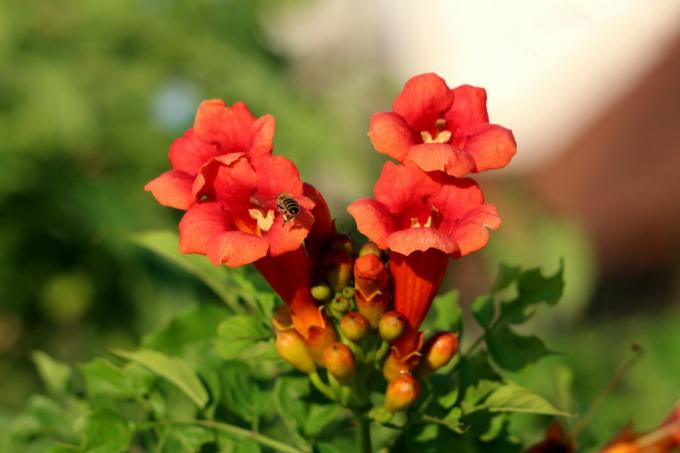Climbing plants not only decorate house walls and walls: they can also be a magnet for insects at the same time. We introduce you to our 13 best bee-friendly climbing plants.

Plants that attract insects don't have to be limited to horizontal surfaces. Insect-friendly climbing plants make it possible to green vertical surfaces and provide bees, bumblebees and the like with a food base. You can transform your house wall, garage or carport into a fragrant and buzzing sea of flowers. We present the 13 best climbing plants for insects in this article.
contents
- Herbaceous vetch
- Clematis
- Bell vine
- Black-eyed Susan
- Wisteria
- honeysuckle
- Virgin vine
- Winter jasmine
- Climbing trumpet
- Passion flower
- Nasturtiums
- Earth pear
- cucumber
Herbaceous vetch
Many people are probably familiar with the vetch (Lathyrus latifolius) from farm or rural front gardens. The well-known climbing plant is not only popular for adding color to garden fences or walls in summer lend - bees, bumblebees and Co. literally fly to the easy-care Climbing plant.

Clematis
the Clematis (Clematis) not only delights us with its beautiful and lush flowers all summer long. It also attracts insects and bees. Some clematis species, such as Clematis alpina, Clematis vitalba or Clematis integrifolia are also hardy and can therefore be cultivated for several years.
Bell vine
Bell vines (Cobaea scandens) are also called bell winds or claw winds and are valued for their rapid growth. As a result, the climbing plant quickly forms a privacy screen for the balcony or in the garden. In addition: The imposing, purple flowers attract many beneficial organisms, such as bees, bumblebees and insects, into your garden from June until the first frost.

Black-eyed Susan
A classic among the climbing plants is the black-eyed Susanne (Thunbergia alata). But the plant can also be seen as an insect magnet. The orange flowers with the distinctive black point in the middle are only too popular with all kinds of insects.
Wisteria
On the list of hardy, bee-friendly climbing plants, the Wisteria (Wisteria) definitely not be missing. Bees, bumblebees and co. Particularly like to fly to the blue flowers. The plant is also one of the nutritious trees for bees. And birds also love to nibble on the buds of the climbing plant in spring. But be careful: wisteria is poisonous for humans!
honeysuckle
It is also hardy and an insect magnet honeysuckle (Lonicera henryi). The reddish-yellow flowers smell wonderful from June to July and attract all kinds of winged insects into your garden. With a height of up to four meters, the honeysuckle is also wonderfully suitable for greening larger areas.

Virgin vine
Even for bee lovers without green fingers, nature has a lot to offer climbing plants. One of them is the virgin vine (Parthenocissus tricuspidata), also known as wild wine. Over a period of several years and extremely easy to care for, the virgin vine effortlessly climbs up house facades or walls. The yellow flowers are rather small and inconspicuous, but offer insects plenty of opportunity to eat their fill.
Winter jasmine
Also the Winter jasmine (Jasminum nudiflorum) is a bee-friendly climber. It provides insects with a source of food when many other plants are far from blooming. As early as December, but no later than February to the end of April, the small, yellow flowers attract insects.
Tip: Creating a bee- and beneficial insect-friendly garden is even easier with the insect-friendly seeds from Plantura. Our Plantura beneficial organism magnet attracts many of the small, winged helpers and offers numerous animals a home in your garden. We make sure that our seeds are environmentally friendly and sustainable. This will benefit you, nature, insects and your garden the most.
Climbing trumpet
The climbing trumpet (Campsis) not only a feast for the eyes, but also an insect magnet. It is hardy and perennial and does not make great demands. The main flowering time is from August to the end of September.

Passion flower
The exotic ones are a real eye-catcher in the garden Passion flowers (Passiflora). The flowers are not only popular with us, but also with insects: The extravagant flowers attract bees, bumblebees and Co. in droves. Some varieties of passion flower are even hardy and can be cultivated for several years. These include, for example, the blue passion flower (Passiflora caerulea) or the flesh-colored passion flower (Passiflora incarnata).
Nasturtiums
Another insect-friendly climber is the Nasturtiums (Tropaeolum). Not only do we like to enjoy the hot flowers in salads - the red, yellow and orange flowers are also a real feast for insects and bees.
Earth pear
A still rather unknown exotic among the climbing plants is that Earth pear (Apios). the Butterflies have dark red flowers that smell spicy and provide the insects with plenty of food from August onwards. In addition, the climbing plant is hardy.
cucumber
When you think of bee-friendly climbing plants, the ordinary one may not come first cucumber (Cucumis sativus) to mind. However, useful plants can serve as an insect buffet just as well as ornamental plants. The yellow flowers bloom from June to August and are popular with beneficial insects and other insects.

Our Top 10 hardy climbing plants can be found in our special article.
